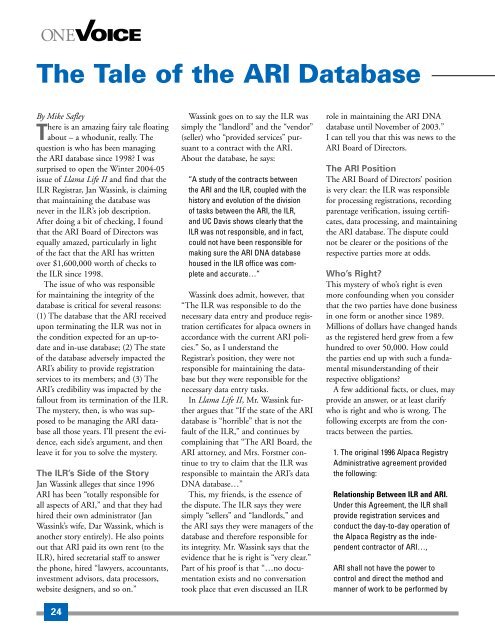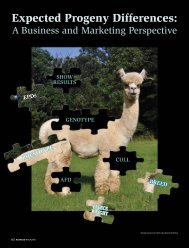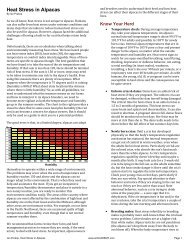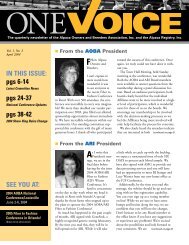IN THIS ISSUE: pg 4 pgs 9, 11 pgs 11-20 SEE YOU AT: - ariLIST
IN THIS ISSUE: pg 4 pgs 9, 11 pgs 11-20 SEE YOU AT: - ariLIST
IN THIS ISSUE: pg 4 pgs 9, 11 pgs 11-20 SEE YOU AT: - ariLIST
Create successful ePaper yourself
Turn your PDF publications into a flip-book with our unique Google optimized e-Paper software.
The Tale of the ARI Database<br />
By Mike Safley<br />
There is an amazing fairy tale floating<br />
about – a whodunit, really. The<br />
question is who has been managing<br />
the ARI database since 1998? I was<br />
surprised to open the Winter <strong>20</strong>04-05<br />
issue of Llama Life II and find that the<br />
ILR Registrar, Jan Wassink, is claiming<br />
that maintaining the database was<br />
never in the ILR’s job description.<br />
After doing a bit of checking, I found<br />
that the ARI Board of Directors was<br />
equally amazed, particularly in light<br />
of the fact that the ARI has written<br />
over $1,600,000 worth of checks to<br />
the ILR since 1998.<br />
The issue of who was responsible<br />
for maintaining the integrity of the<br />
database is critical for several reasons:<br />
(1) The database that the ARI received<br />
upon terminating the ILR was not in<br />
the condition expected for an up-todate<br />
and in-use database; (2) The state<br />
of the database adversely impacted the<br />
ARI’s ability to provide registration<br />
services to its members; and (3) The<br />
ARI’s credibility was impacted by the<br />
fallout from its termination of the ILR.<br />
The mystery, then, is who was supposed<br />
to be managing the ARI database<br />
all those years. I’ll present the evidence,<br />
each side’s argument, and then<br />
leave it for you to solve the mystery.<br />
The ILR’s Side of the Story<br />
Jan Wassink alleges that since 1996<br />
ARI has been “totally responsible for<br />
all aspects of ARI,” and that they had<br />
hired their own administrator (Jan<br />
Wassink’s wife, Dar Wassink, which is<br />
another story entirely). He also points<br />
out that ARI paid its own rent (to the<br />
ILR), hired secretarial staff to answer<br />
the phone, hired “lawyers, accountants,<br />
investment advisors, data processors,<br />
website designers, and so on.”<br />
24<br />
Wassink goes on to say the ILR was<br />
simply the “landlord” and the “vendor”<br />
(seller) who “provided services” pursuant<br />
to a contract with the ARI.<br />
About the database, he says:<br />
“A study of the contracts between<br />
the ARI and the ILR, coupled with the<br />
history and evolution of the division<br />
of tasks between the ARI, the ILR,<br />
and UC Davis shows clearly that the<br />
ILR was not responsible, and in fact,<br />
could not have been responsible for<br />
making sure the ARI DNA database<br />
housed in the ILR office was complete<br />
and accurate…”<br />
Wassink does admit, however, that<br />
“The ILR was responsible to do the<br />
necessary data entry and produce registration<br />
certificates for alpaca owners in<br />
accordance with the current ARI policies.”<br />
So, as I understand the<br />
Registrar’s position, they were not<br />
responsible for maintaining the database<br />
but they were responsible for the<br />
necessary data entry tasks.<br />
In Llama Life II, Mr. Wassink further<br />
argues that “If the state of the ARI<br />
database is “horrible” that is not the<br />
fault of the ILR,” and continues by<br />
complaining that “The ARI Board, the<br />
ARI attorney, and Mrs. Forstner continue<br />
to try to claim that the ILR was<br />
responsible to maintain the ARI’s data<br />
DNA database…”<br />
This, my friends, is the essence of<br />
the dispute. The ILR says they were<br />
simply “sellers” and “landlords,” and<br />
the ARI says they were managers of the<br />
database and therefore responsible for<br />
its integrity. Mr. Wassink says that the<br />
evidence that he is right is “very clear.”<br />
Part of his proof is that “…no documentation<br />
exists and no conversation<br />
took place that even discussed an ILR<br />
role in maintaining the ARI DNA<br />
database until November of <strong>20</strong>03.”<br />
I can tell you that this was news to the<br />
ARI Board of Directors.<br />
The ARI Position<br />
The ARI Board of Directors’ position<br />
is very clear: the ILR was responsible<br />
for processing registrations, recording<br />
parentage verification, issuing certificates,<br />
data processing, and maintaining<br />
the ARI database. The dispute could<br />
not be clearer or the positions of the<br />
respective parties more at odds.<br />
Who’s Right?<br />
This mystery of who’s right is even<br />
more confounding when you consider<br />
that the two parties have done business<br />
in one form or another since 1989.<br />
Millions of dollars have changed hands<br />
as the registered herd grew from a few<br />
hundred to over 50,000. How could<br />
the parties end up with such a fundamental<br />
misunderstanding of their<br />
respective obligations?<br />
A few additional facts, or clues, may<br />
provide an answer, or at least clarify<br />
who is right and who is wrong. The<br />
following excerpts are from the contracts<br />
between the parties.<br />
1. The original 1996 Alpaca Registry<br />
Administrative agreement provided<br />
the following:<br />
Relationship Between ILR and ARI.<br />
Under this Agreement, the ILR shall<br />
provide registration services and<br />
conduct the day-to-day operation of<br />
the Alpaca Registry as the independent<br />
contractor of ARI…,<br />
ARI shall not have the power to<br />
control and direct the method and<br />
manner of work to be performed by





